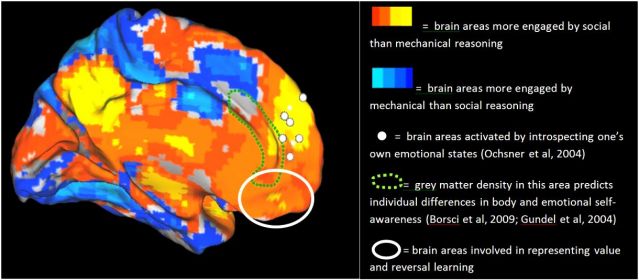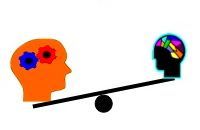Cognition
Brain Imaging Reveals the Diametric Mind
Mentalizing brain areas inhibit mechanistic ones and vice versa.
Posted April 11, 2014

Readers of these posts will by now be familiar with the diametric model of the mind. It holds that we have evolved parallel modes of cognition in relation to the mechanistic world of objects as opposed to the mentalistic world of other people. You just can't kick people out of your path the way you can stones. And as anyone who treats people like objects—or objects like people—soon learns, understanding the difference is crucial. Chronic behavior of the former kind may be diagnosed as autistic, and severe cases of the latter as psychotic, extending the model to mental illness too.
The diametric model of the mind and of mental illness was suggested by autism research, and as originally put forward made no reference to brain-imaging as such. But now remarkable findings by Anthony I. Jack and colleagues reveal that something very like it can indeed be seen at work in the brain. These findings are all the more striking because they were made in ignorance of the diametric model and because their “account has been developed independently of classic dual-process theory and research on moral neuroscience.” In a just-published paper, these researchers argue that, “According to our original theoretical conception (Robbins and Jack, 2006), there are dissociable brain networks specialized for thinking about an entity’s physical (e.g., causal-mechanical) attributes and for thinking about an entity’s subjective mental life”—or what I would call mechanistic and mentalistic cognition respectively (above).
As I pointed out in a previous post, C. P. Snow had famously anticipated the diametric model in his Two Cultures dichotomy, and as Jiro Tanaka’s essay I cite there emphasizes, Snow’s insight highlighted the conflict between mentalistic and mechanistic thinking at the cultural level. But according to Jack and colleagues, “The tension between these networks is a fundamental feature of our neural structure, and is not specific to the domain of moral judgments.” On the contrary, they show that “The network architecture is configured in such a way that the engagement of one stance inhibits the engagement of the other.” Indeed, the term anti-correlated networks has been coined to describe this phenomenon:
social tasks deactivated regions associated with mechanical reasoning and mechanical tasks deactivated regions associated with social reasoning. These findings are not explained by self-referential processes, task engagement, mental simulation, mental time travel or external vs. internal attention, all factors previously hypothesized to explain default mode network activity. ... These results indicate the reciprocal inhibition is not attributable to constraints inherent in the tasks, but is neural in origin.

Almost from the beginning, I illustrated the diametric model with the see-saw diagrams that pepper these posts (left), and it is striking that Jack and colleagues independently use exactly the same symbolism in their summary of their findings: “activity in these networks tends to alternate much like a seesaw. We have shown that tasks involving scientific reasoning, and thinking about the internal mental states of others, push this seesaw to both extremes.”
But not only do the new findings suggest similar symbolism, they imply an evolutionary rationale in words that could have been used to describe the diametric model:
We hypothesize that we evolved two distinct networks to do the cognitive processing required to guide distinct types of interaction: manipulating inanimate objects and engaging with conscious agents. Two broad cognitive modes correspond to these two types of interaction: analytic thinking and empathetic engagement. The first cognitive mode, which includes logical, mathematical, and causal-mechanical reasoning, was built upon our more primitive capacities for sensory processing and the control of action. Because it is built upon evidence from the senses, it can be thought of as an empirical mode of thinking. The second cognitive mode, which plays a key role in social bonding, moral cognition, introspection, and emotional insight, was built upon our more primitive capacities for visceral awareness and emotional self-regulation. This second cognitive mode is the default mode for unguarded social interactions, in particular between a parent and child but also more generally for in-group members — in other words, for anyone whom we humanize.
As my colleague and co-author of the imprinted brain theory, Bernard Crespi, points out, now it is a matter of linking these anti-correlated networks to genetic/epigenetic variation. Here the predictions of our theory are clear: female and maternal gene expressions should correlate more with mentalism, male and paternal ones more with mechanistic cognition. Existing evidence of sex differences in cognition, behavior, and psychopathology already strongly suggest that this is indeed the case, and If it could also be demonstrated in brain development, the new paradigm would not simply be psychiatry’s “grandest working theory since Freud, and one at the forefront of science,” it would be one at the forefront of neuroscience too.
(With thanks to Bernard Crespi for bringing this to my attention and to Anthony Jack for his kind cooperation. Illustration at top reproduced with permission from Anthony I. Jack, "A scientific case for conceptual dualism: The problem of consciousness and the opposing domains hypothesis." to appear in: J. Knobe, T. Lombrozo & S. Nichols (Eds) Oxford Studies in Experimental Philosophy.)


